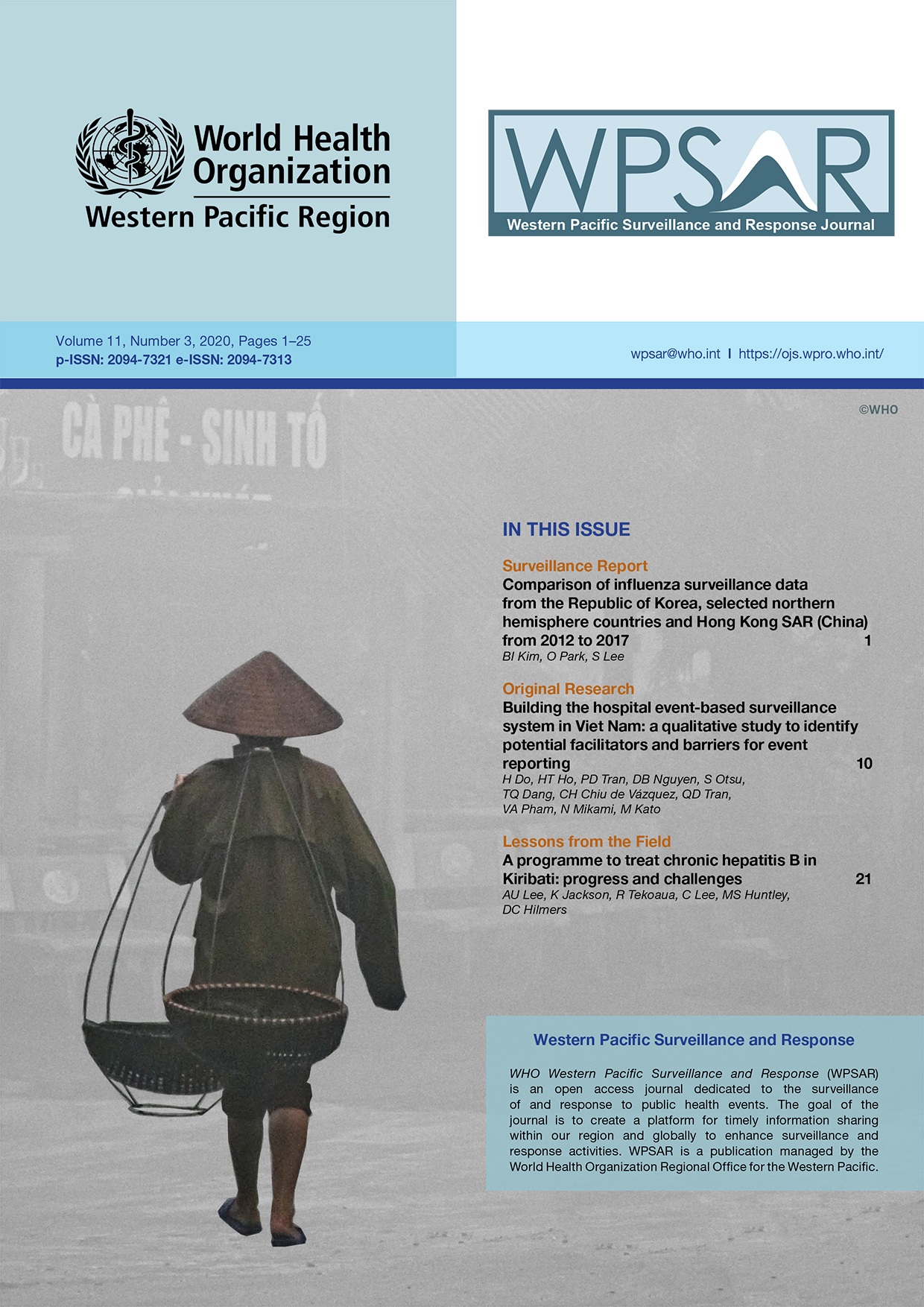Building the hospital event-based surveillance system in Viet Nam: a qualitative study to identify potential facilitators and barriers for event reporting
DOI:
https://doi.org/10.5365/wpsar.2019.10.1.009Abstract
Introduction: Hospitals are a key source of information for the early identification of emerging disease outbreaks and acute public health events for risk assessment, decision-making and public health response. The objective of this study was to identify potential facilitators and barriers for event reporting from the curative sector to the preventive medicine sector in Viet Nam.
Methods: In 2016, we conducted 18 semi-structured, in-depth interviews, as well as nine focus group discussions, with representatives from the curative and preventive medicine sectors in four provinces. We transcribed the interviews and focus group discussions and used thematic analysis to identify the factors that appeared to affect public health event reporting.
Results: We identified five major themes. First, the lack of a legal framework to guide reporting meant hospital staff relied on internal procedures that varied from hospital to hospital, which sometimes delayed reporting. Second, participants stated the importance of an enabling environment, such as leadership support and having focal points for reporting, to facilitate reporting. Third, participants described the potential benefits of reporting, such as support provided during outbreaks and information received about local outbreaks. Fourth, some challenges prohibited timely reporting such as not perceiving reporting to be the task of the curative sector and hesitancy to report without laboratory confirmation. Finally, limited resources and specialist capacities in remote areas hindered timely detection and reporting of unusual events.
Discussion: This study identified potential opportunities to promote the detection and reporting of unusual events from health-care workers to the public health sector, and thus to improve the overall health security system in Viet Nam.The influenza virus is a respiratory pathogen that is transmitted through respiratory droplets.1 During seasonal influenza epidemics, high attack rates cause a significant public health burden.2 The infection is usually self-limited in young adults but can lead to severe infections in people in high-risk groups, including elderly people (> 65 years old), pregnant women, children aged 6–59 months and adults with chronic illnesses.3
References
World Health Organization. (2016). International Health Regulations (2005) (3 ed.).
World Health Organization. (2016). Asia Pacific Strategy for Emerging Diseases and Public Health Emergencies.
Ministry of Health, The Socialist Republic of Viet Nam. (2014). Decision: approving “event-based surveillance (EBS) procedures.” No. 134/QD-DP. Hanoi (Vietnam): General Department of Preventive Medicine, Vietnam Ministry of Health.
MacDonald, E., Aavitsland, P., Bitar, D., & Borgen, K. (2011). Detection of events of public health importance under the international health regulations: a toolkit to improve reporting of unusual events by frontline healthcare workers. BMC Public Health, 11, 713. doi: 10.1186/1471-2458-11-713
Konowitz, P. M., Petrossian, G. A., & Rose, D. N. (1984). The underreporting of disease and physicians' knowledge of reporting requirements. Public Health Rep, 99(1), 31-35.
Tan, H. F., Yeh, C. Y., Chang, H. W., Chang, C. K., & Tseng, H. F. (2009). Private doctors' practices, knowledge, and attitude to reporting of communicable diseases: a national survey in Taiwan. BMC Infect Dis, 9, 11. doi: 10.1186/1471-2334-9-11
Dagina, R., Murhekar, M., Rosewell, A., & Pavlin, B. I. (2013). Event-based surveillance in Papua New Guinea: strengthening an International Health Regulations (2005) core capacity. Western Pac Surveill Response J, 4(3), 19-25. doi: 10.5365/WPSAR.2013.4.2.001
Krause, G., Ropers, G., & Stark, K. (2005). Notifiable disease surveillance and practicing physicians. Emerg Infect Dis, 11(3), 442-445. doi: 10.3201/eid1103.040361
Friedman, S. M., Sommersall, L. A., Gardam, M., & Arenovich, T. (2006). Suboptimal reporting of notifiable diseases in Canadian emergency departments: a survey of emergency physician knowledge, practices, and perceived barriers. Can Commun Dis Rep, 32(17), 187-198.
Figueiras, A., Lado, E., Fernandez, S., & Hervada, X. (2004). Influence of physicians' attitudes on under-notifying infectious diseases: a longitudinal study. Public Health, 118(7), 521-526. doi: 10.1016/j.puhe.2003.12.015
Ki, M. (2015). 2015 MERS outbreak in Korea: hospital-to-hospital transmission. Epidemiol Health, 37, e2015033. doi: 10.4178/epih/e2015033
Lee, S. I. (2015). Costly Lessons From the 2015 Middle East Respiratory Syndrome Coronavirus Outbreak in Korea. J Prev Med Public Health, 48(6), 274-276. doi: 10.3961/jpmph.15.064
Turnberg, W., Daniell, W., & Duchin, J. (2010). Notifiable infectious disease reporting awareness among physicians and registered nurses in primary care and emergency department settings. Am J Infect Control, 38(5), 410-412. doi: 10.1016/j.ajic.2009.07.013

